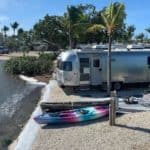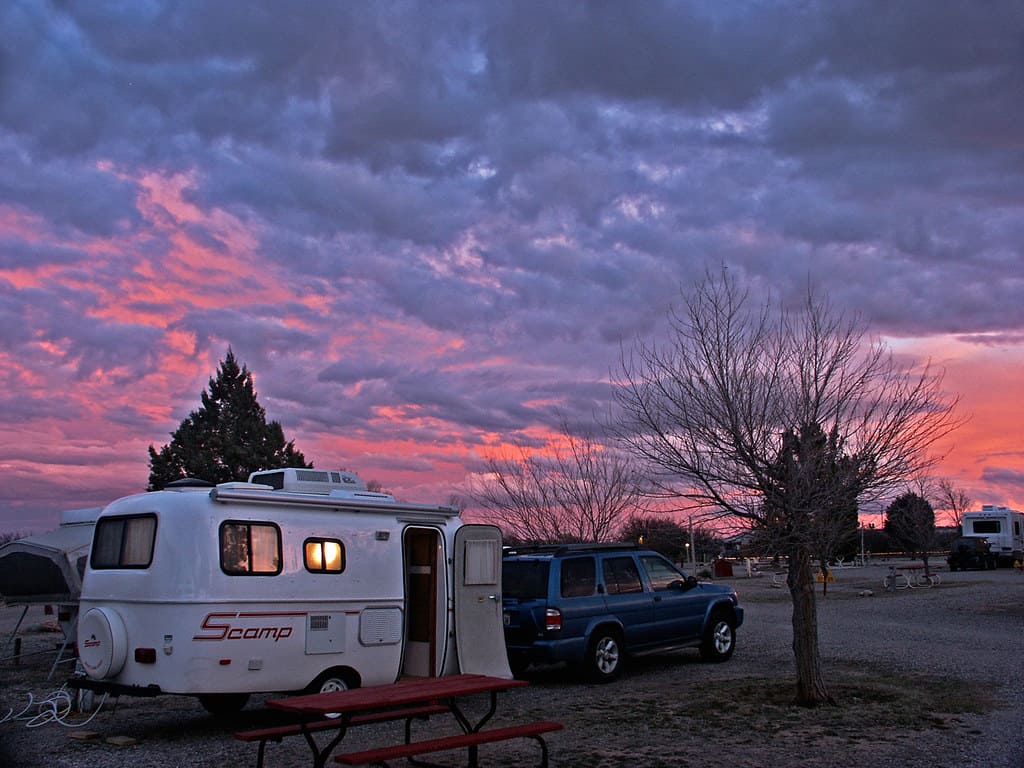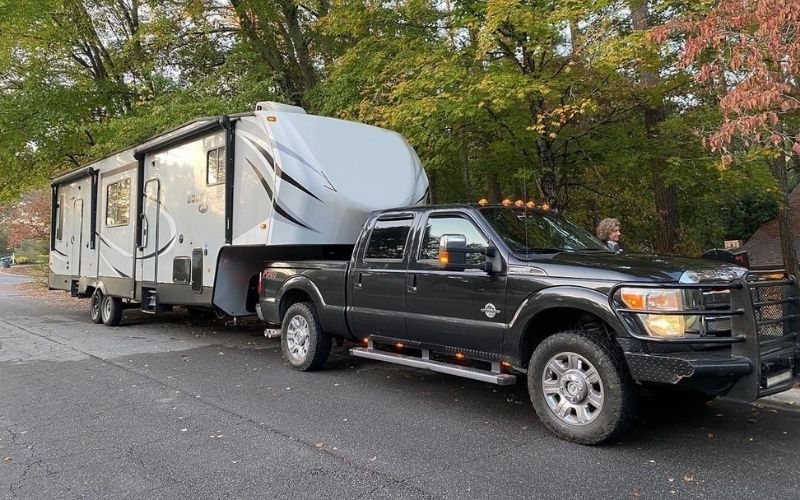We take off in our RV’s for greater freedom, and some of the best moments in our campers come hours away from the nearest fuel station.
Navigating some bigger rigs isn’t an easy task, so most of us will want to fill up our tanks when it’s convenient rather than desperately searching for options when it’s necessary.
Information pertaining to the Miles Per Gallon of your rig is often easily accessible, but knowing how much gas your tank holds is just as important and frequently neglected by new owners.
Your gas tank size is the key to understanding exactly how far your RV will take you before you have to stop off at a gas station.
The average RV gas tank size varies per Class. A Class A tank leads the way at 100-gallon tanks on average, Class B RVs hold 24 gallons, and Class C RV will hold 25 gallons.
The in-depth answers are much more complicated than these averages. Read on to about the gas consumption of each Class of RV, different RV gas tank sizing, fuel consumption tips, to make sure you accurately plan out your fuel stops and spend less time on your adventure searching for Texacos.
How Many Gallons Of Gas Does The Average RV Hold?
The average RV gas tank size is between 25 and 150 gallons and varies per Class.
RV Class | Gas Tank (in gallons) | MPG | Miles you Can Travel on One Tank |
Class A | 80 to 150 | 8 to 12 | 800 - 1200 |
Class B | 18 to 26 | 19 to 24 | 475 - 600 |
Class C | 25 to 55 | 15 to 17 | 400 - 900 |
No matter how big your gas tank size is, you should make sure to fill it up before it gets too low.
Pay close attention to your fuel gauge. Running on empty can risk permanent damage to your RV’s engine and lower your rig’s overall fuel economy.
Plus, once the needle gets towards E, your relaxing drive through unfettered terrain becomes a nerve-wracking experience.
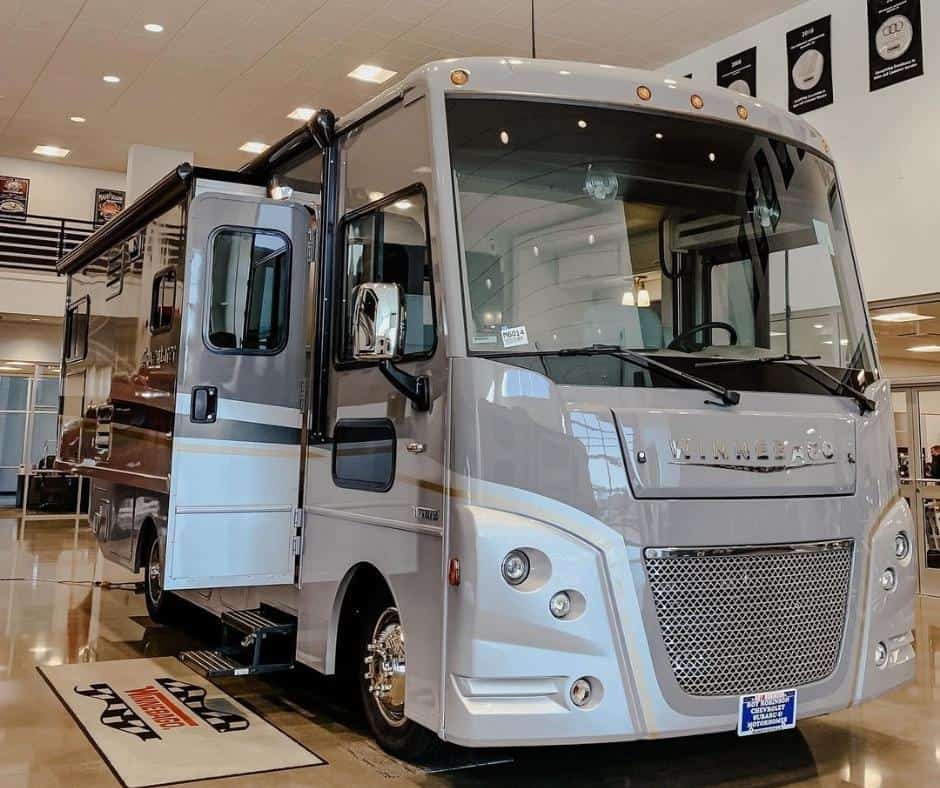
How Many Gallons Of Fuel Does A Class A Motorhome Hold?
This class of RV is the biggest of the bunch. More like homes on wheels than anything else, these heavy units demand tons of fuel.
Manufacturers have combated this necessity by supplying Class A RV’s with the largest gas tanks out of any option:
| Class A | 80 to 150 Gallons | 8 to 12 MPG | 800 – 1200 miles |
This sizable tank prevents frequent fill-ups, which is ideal, as navigating rigs the size of Class A RV’s around a pump station is no easy task.
Use this large gas tank to your advantage by only filling up at truck stops; gas stations designed to handle larger vehicles.
Off most major highways, you’ll find easy on/off access to fuel stations that accommodate a larger vehicle.
Most of these stations will also pack in handy convenience extras like dump stations, showers, and car part shops, to provide a one-stop-shop for all your trip needs.
Don’t forget to stop at one before you get back home, so you can start your next trip with a full tank of gas.
The largest Class in terms of height, length, and weight, it comes as no surprise that this class of RV requires the most gas to get rolling.
With a considerable average gas tank size, you can confidently take off towards the unknown for miles of freedom. Here are a few examples of well known Class A RV’s and their fuel capacities.
Model | Gas Tank | MPG | Miles Per Tank |
Forest River Berkshire | 100 | 9 | 900 |
Coachmen Pursuit | 80 | 7 | 560 |
Thor Aria | 100 | 8 | 800 |
How Far can a Class A Gas tank take you?
Depending on your vehicle’s fuel economy, 100 gallons of gas at 8 to 12 MPG can mean various destinations are within reach.
A 100-gallon tank could take you somewhere between 800-1200 miles. Long-haul RVers will feel the benefit of that larger tank.
One thousand two hundred miles would take you through most of the United State’s East Coast in one tank if you were to do it in one straight drive.
Cities, Highways, and mountain roads all have a different impact on your drivetrain, but your MPG shouldn’t vary more than a mile or two between each fill-up.
If you’re experiencing a hefty drop in MPG, that can signal something worse going on underneath the hood.
Most Class A RVs have diesel engines that help the fuel efficiency stay serviceable. The fact is, the heavy chassis that supports an exorbitant amount of luxury on the interior will drain your tank.
If MPG is the primary concern for your journey, you should consider another class of RV.
With all the turnoff you’ll take for campgrounds and sights, you’ll most likely find you’re filling up more often than 1200 miles, but the large tank still opens up loads of freedom.
Class B Gas Tank Size
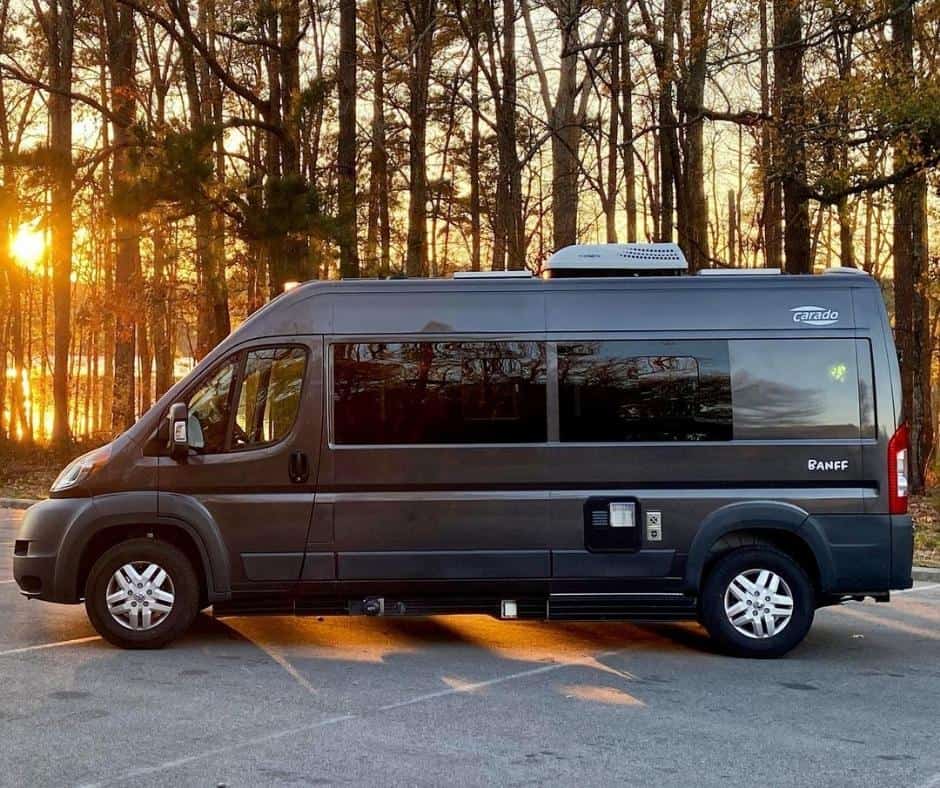
Class B RVs smaller size is favored by solo or duo travelers, in large part due to their increased fuel economy:
| Class B | 18 to 26 Gallons | 19 to 14 MPG | 475 – 600 Miles Per tank |
Class B RVs have sacrificed more comforts of home than other options in favor of convenience, as these RVs will fit in a standard parking lot and are capable of being driven over rough terrain.
Some of the RVs in this class are glorified cargo vans. They are the easiest RVs to drive, and this makes them the easiest to refuel.
While it’s still essential to plan your refueling stations along your route, a Class B RV will have no trouble navigating tight spaces.
With efficiency in mind at every corner of the design, a class B gas tank will take you much further and allow you to do more if you’re willing to sacrifice a bit of comfort to get there.
Here are the capabilities of some popular models.
Model | Gas Tank | MPG | Miles Per Tank |
Airstream Atlas | 24.5 | 18 | 441 |
Roadtrek Zion | 24 | 17 | 408 |
Winnebago Travato | 24 | 21 | 504 |
How Far can a Class B Gas tank take you?
Class B’s made in the 2010s have improved leaps and bounds in overall fuel economy from older models.
By far, this class has the best MPG of any RV on the market, and the fuel efficiency more than makes up for the smaller tank size.
Some high-end Class B RVs run on a diesel engine that can stretch out the MPG a bit further, but most of the class use a gasoline engine.
Class B’s can lose some MPG when taken over rough terrain, which is the only drawback to the enhanced driving capabilities of the class.
Don’t expect to get high gas mileage when you’re tramping down rough National Forest Service Roads.
Expect your Class B tank to take you about the same distance as your everyday vehicle, depending on which roads you are driving down.
This is only half the distance a tank of gas would move a Class A RV, but the tank is a quarter of the size, so Class B provides a more efficient overall experience.
Class B’s sacrifice comfort for performance at several different benchmarks, and the gas tank size and fuel efficiency of the class reaps the benefits of the cramped living spaces.
Class C Gas Tank Size
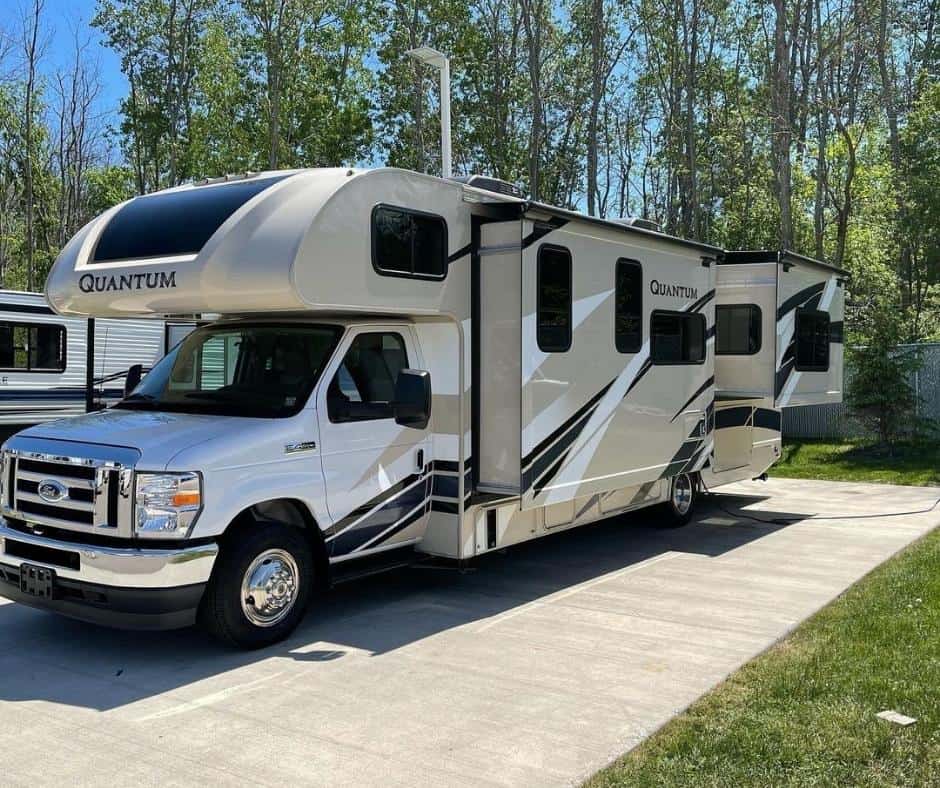
Class C RVs feature more variation in length, and therefore gas tanks than other RV classes:
| Class C | 25 to 55 Gallons | 15 to 17 MPG | 400 – 900 Miles Per Tank |
These RVs seek to provide some of the same comforts of a Class A mobile home in a smaller package.
Even though this average gas tank size of a Class C motorhome is much smaller, you’ll find a more leisurely time maneuvering a Class C RV and still have plenty of comforts of home travel with you.
Some manufacturers of Class C RVs have emphasized different parts of the experience, so you’ll find significant variants in gas tanks.
The most giant Class C RV gas tank will hold 100 gallons of gas, much closer to the capabilities of a Class A.
Most often, your Class C will come with either a 25 or 55-gallon tank. The class looks to strike a balance between the other two subsections of RVs.
They favor slightly more towards a Class A than a Class B. The larger the RV, the larger the gas tank. Here are a few of the industry leading capabilities.
Model | Gas Tank | MPG | Miles Per Tank |
Coachmen Concord | 57 | 11 | 627 |
Forest River Forester TS | 25 | 15 | 375 |
Gulf Stream BT Cruiser | 55 | 14 | 770 |
How Far can your Class C tank Take You?
Class C RVs have shed tons of weight that plagues the larger class A campers. This fuel efficiency is nothing to sneeze at, comparable to the MPG available in a 4WD truck.
The balance Class C’s seek to strike between RV options is evident in the fuel economy. 16 MPG’s is just barely less than some Class B campers, and the class provides many creatures comforts not seen in the smaller class.
A large amount of variation in this RV subcategory will also become evident in the fuel economy, so it is essential to understand the MPG of the specific model of Class C RV you are looking to take home.
Diesel Vs. Gasoline
Each engine type has serious pros and cons. It all depends on whether you want to save money upfront during your vehicle purchase or ten years down the line.
Diesel engines are more fuel-efficient engines that can last longer than your typical gasoline engines.
That’s why you see them so often employed on long-haul trucks or other big rigs. The engines have been known to last for over 300,000 miles easily.
Gas RV’s are easier to maintain and afford and are better for high altitude driving, especially when towing.
You can’t expect much more than 200,000 miles out of these engines, which will lower the resell value of your rig.
The kicker is the entry price. Diesel fuel can sometimes be more expensive, and RV’s with a diesel engine will generally be a much higher price than a typical gasoline engine.
There’s no wrong answer, and the specific engine size your rig uses won’t affect its gas tank size.
How to Calculate your MPG
Most of these averages are just that: average. With thousands of different RVs taking off across the country every day, your experience is likely to slightly differ from national standards.
To better understand how far you can go on your gas tank, you can take steps to understand your personal MPG.
The information that comes with your vehicle may be slightly sugar-coated, which is fine when making a sale but less than ideal when you find yourself running out of gas a few miles short of the station.
With a few steps and some simple math, you can figure out exactly how many miles you are moving per gallon:
Knowing this information will allow you to do more than plan out your next road trip. It will also let you stay constantly aware of your driving habits and help you improve your MPG.
We eventually turned these statistics gathering into a competition in our rig, which makes us continually strive to improve our gas mileage and save money.
How to Improve your MPG
Your gas tank can get you farther than you’d think, but you’ll spend plenty of time at the pump.
You may be surprised the first time you calculate your actual MPG. It will almost always be less than the advertised numbers. Don’t give up hope based on one bad test result.
There are a few quick adjustments you can make to your RV and yourself to help improve the performance of your vehicle.
Improve your Vehicles Performance
Conscious RV owners are always looking for minor tweaks that will save some money by increasing the aerodynamic properties of your RV.
These changes won’t even involve a trip to the mechanic, and they can have a quantifiable impact on your gas mileage.
High-Quality Motor Oil
It may not seem worth it to shell out the extra bucks for top-shelf motor oil, but spending a few dollars here and there could end up saving you money on gas in the long run.
High-quality motor oil allows your engine to run smoother, which in turn allows your RV to run at high speeds without demanding more fuel.
Keep it All Inside
Strapping extra toys to the roof of your RV will have a massive effect on your vehicle’s aerodynamic capabilities.
A larger RV is already heavily affected by wind resistance, and adding anything on to that will force your engine to work harder to achieve the same speeds.
Inflate Your Tires
Consult your vehicle’s manual or even the tires themselves to find the tire’s best working pressure. This is not an arbitrary number.
Underinflated tires have more surface area touching the pavement than properly inflated tires, and each extra nanometer of contact will slow down your vehicle.
Driving Tips
As hard as it is to admit, some of the best improvements in our MPG will come from within ourselves.
These simple changes won’t affect your arrival times heavily and will go a long way towards saving you a few stops for fill-ups.
Keep Things Smooth
If you see stop-and-go traffic up ahead, ease off the gas early to coast for as long as possible.
Whenever you can, don’t alternate between brakes and acceleration to get through traffic.
Every time you push down on the pedal, you feed gas into your tank. Minimize last-minute speed adjustments and enjoy a more fluid drive.
Relinquish Control
Cruise Control is an incredibly fuel-efficient feature. Take your foot off the gas and take a break, all while saving trips to the gas station with this powerful feature.
Cruise Control works by keeping things at a steady speed, which means that as long as you’re heading down a flat road, the function can keep fuel drain to a minimum.
It’s Okay To Go Slow
Nobody should be taking their RV into the fast lane. When you’re heading uphill, this rings especially true.
Disengage cruise control and accept a slow pace while climbing mountains. The bigger your RV, the more it has to haul over ridges.
Taking your RV into the wild should never be a rushed experience, and taking the next mountain range at 50 instead of 70 will save you gallons.
Research is a crucial aspect of planning. Let this information help guide your next trip and drive worry-free through great backroad escapes.
RV gas tank sizes vary by class, manufacturer, and model. No matter which style you drive, being aware of your RV gas tank size and fuel efficiency will give you further peace of mind while exploring.


